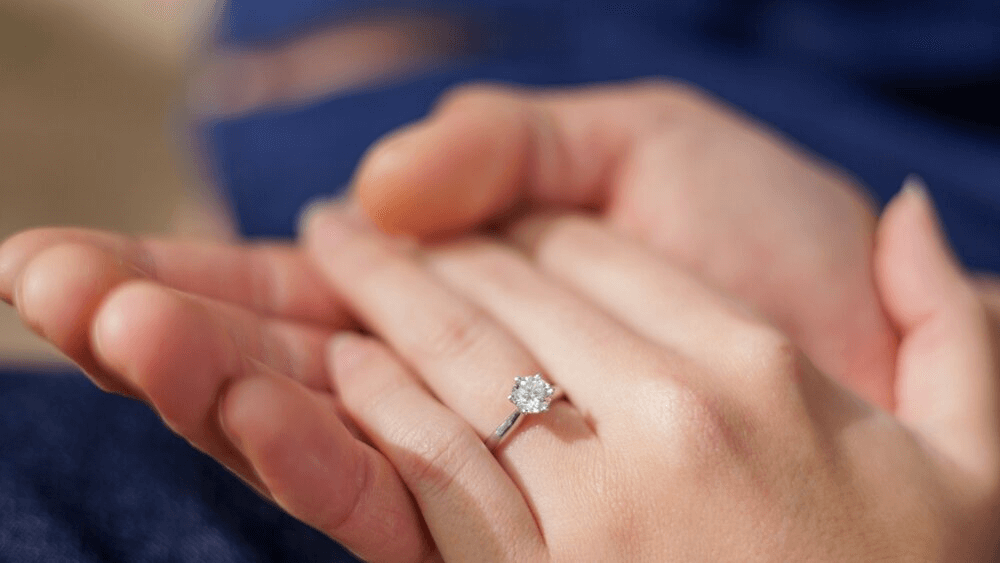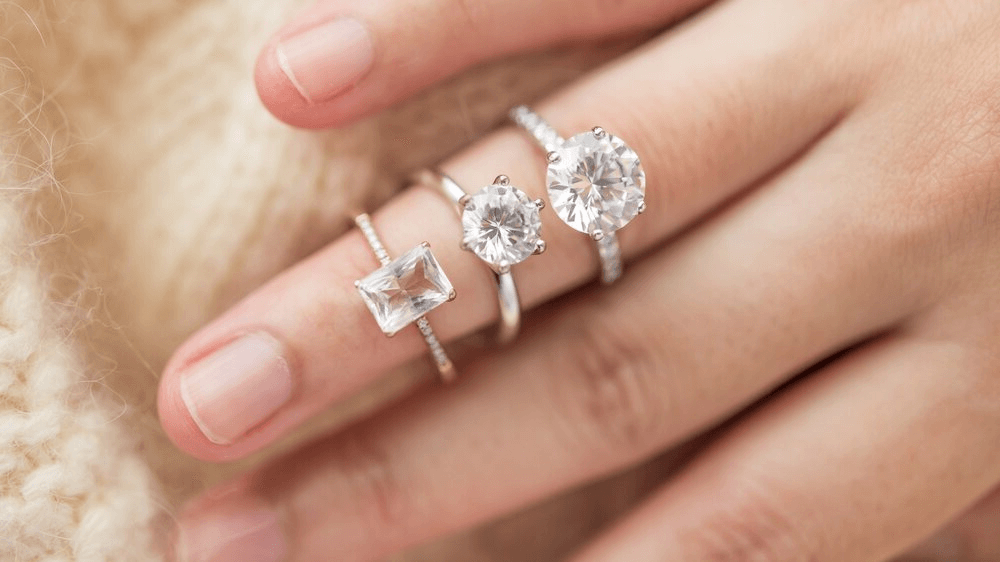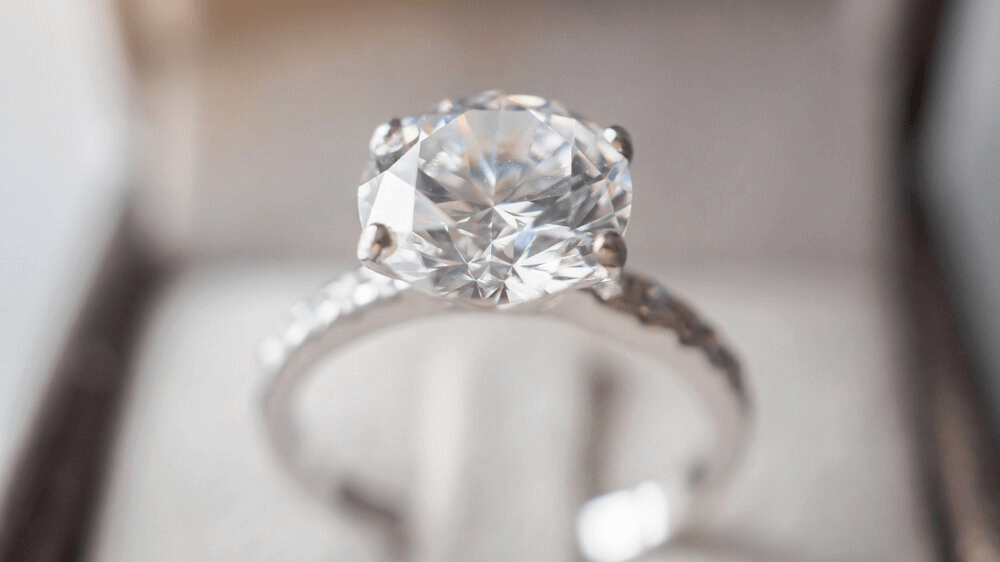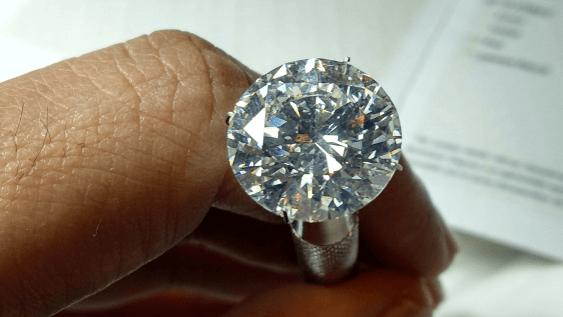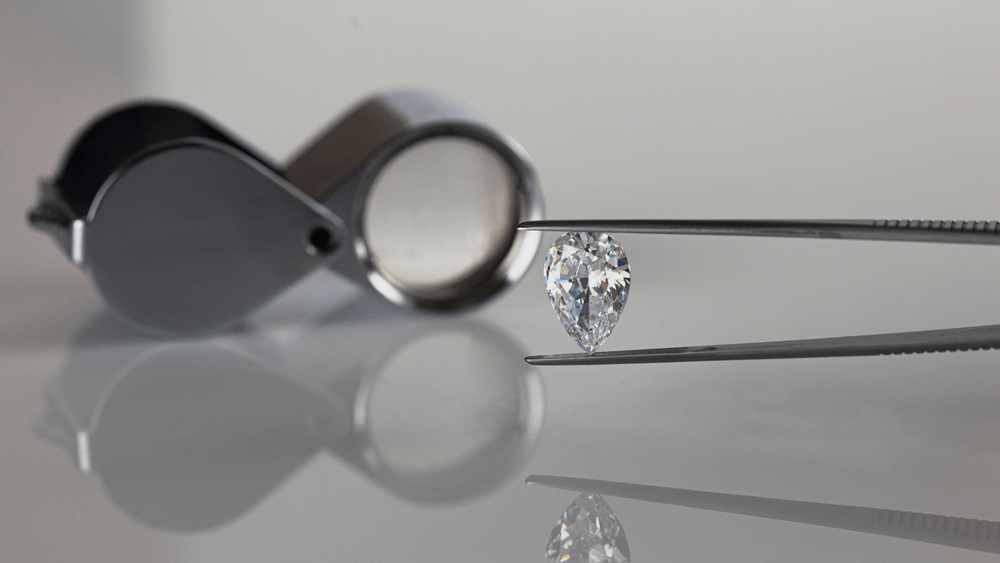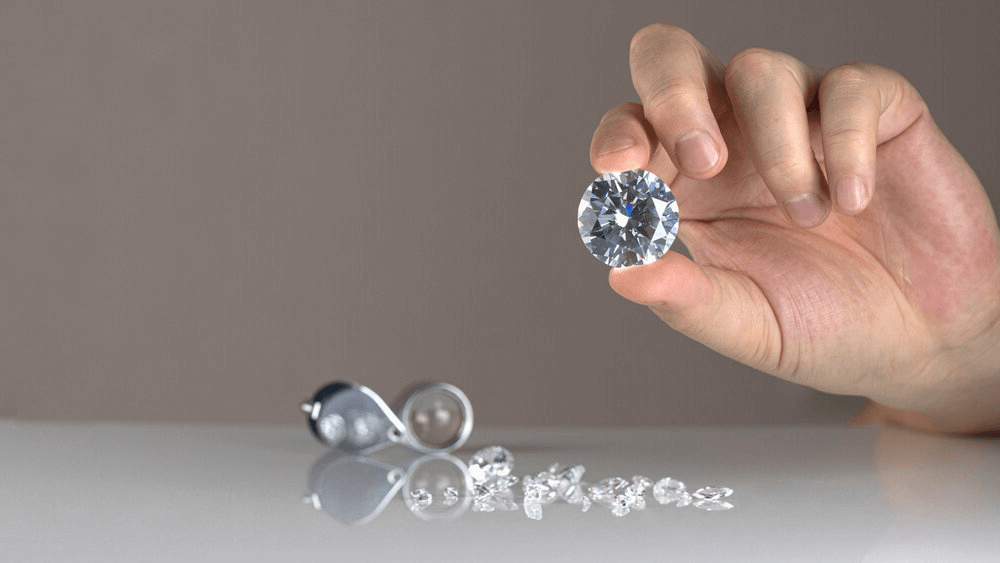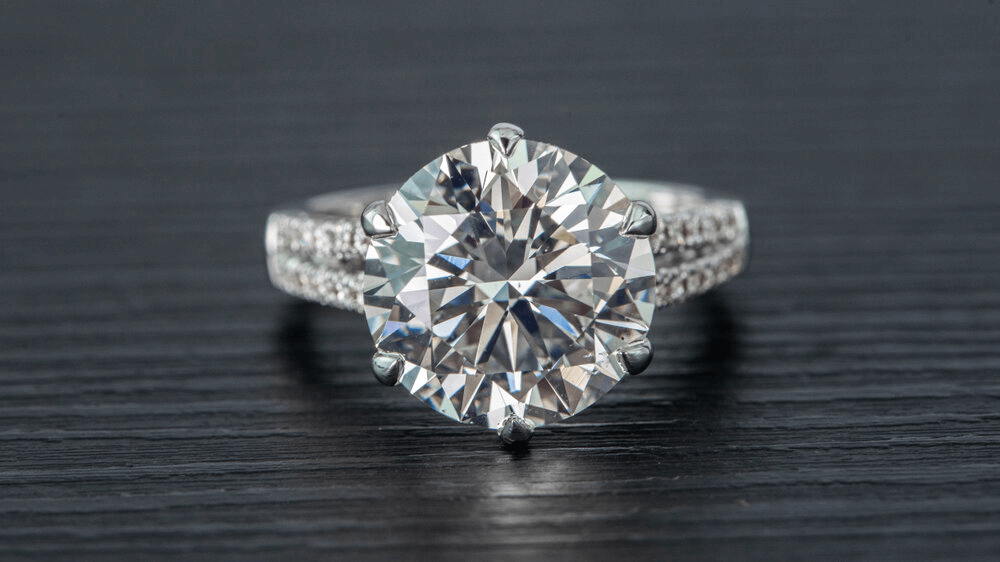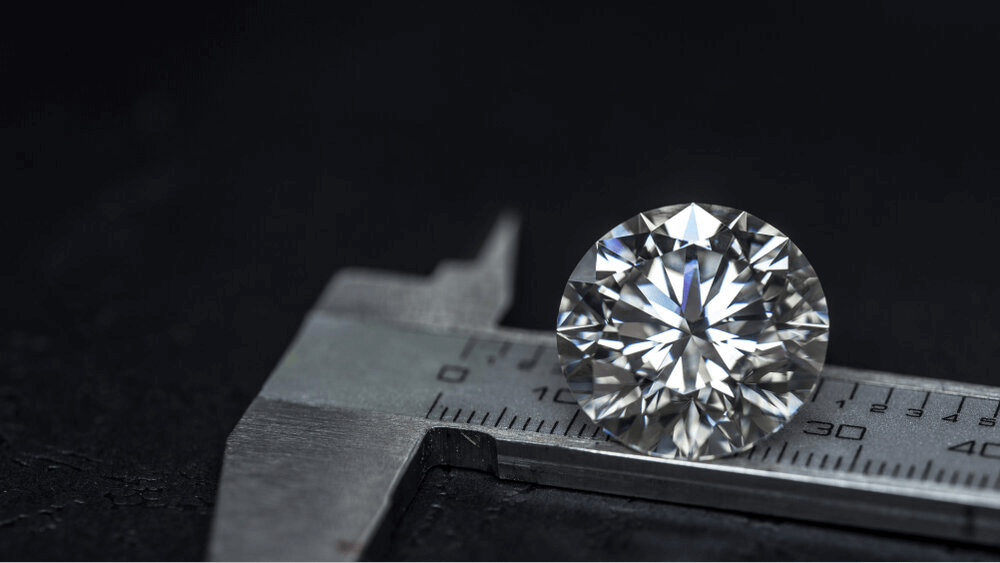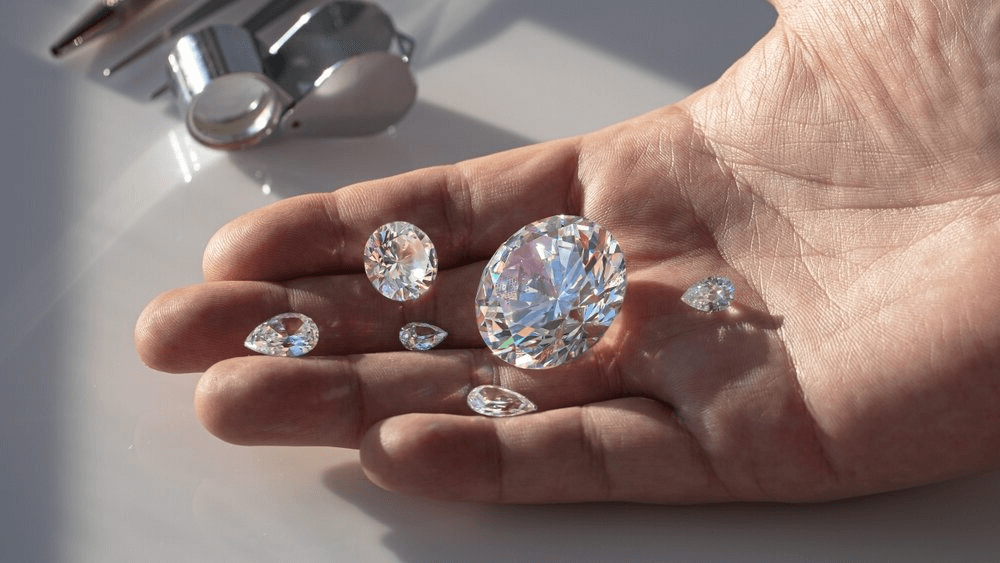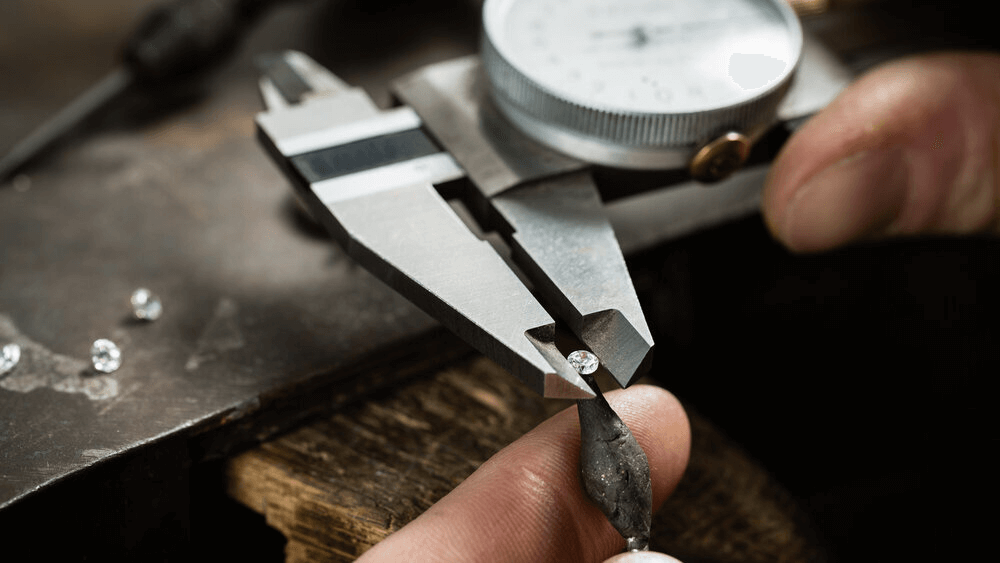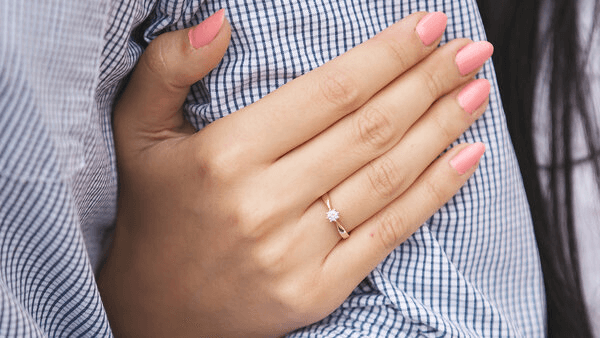Price Alert: Don’t Overpay for a 1 Carat Diamond Ring!

By Gary A.

Edited by Olivia H.
Published Jul 5, 2021
Edited on Dec 18, 2024
When it comes to balancing elegance and impact, a 1 carat diamond hits the sweet spot, offering just the right mix of size and sparkle for those seeking a timeless engagement ring.

Navigate This Guide:
- 14 Quick Tips for Buying a 1 Carat Diamond Engagement Ring
- Introduction
- Understanding Diamond Pricing
- Market Insights and Average 1 Carat Diamond Prices
- Natural vs Lab-Grown 1 Carat Diamonds
- Shopping Avenues: Online vs Retail
- Our Expert Take
- 7 FAQs
Before we dive deeper into the specifics, here are some practical tips to help guide your decision-making process:
14 Quick Tips for Buying a 1 Carat Diamond Engagement Ring
- Tip 1: Understanding the Four Cs: Carat Weight: A 1 carat diamond is a popular choice, but it’s crucial to consider the overall quality, not just the weight. Sometimes, a slightly smaller diamond with better clarity or color can be more valuable.
Clarity: Look for a diamond that is eye-clean. This means inclusions and blemishes are not visible to the naked eye, which often makes diamonds like SI1 and VS2 grades a good balance of quality and cost.
Color: Consider diamonds in the Near Colorless range (G-J). These offer a good balance between a colorless appearance and a lower price point.
Cut: A well-cut diamond will exhibit more sparkle and brilliance. For 1 carat diamonds, prioritize a high cut grade, as it greatly influences the stone’s appearance. - Tip 2: Balancing Size with Quality Size vs. Quality: Understand that a bigger diamond doesn’t always mean a better diamond. A smaller diamond with higher clarity, better color, and excellent cut can be more desirable than a larger stone with poor qualities.
- Tip 3: Proportions Matter: Ensure the diamond’s cut proportions maximize its brilliance and fire. Even a 1 carat diamond can look dull if poorly cut.
- Tip 4: Checking the Diamond Under Different Conditions and Various Lighting: Examine the diamond in different lighting environments. A diamond might look brilliant under the jeweler’s lighting but different in natural light. Its true character is best revealed under a variety of conditions.
Observe for Sparkle: Pay attention to how the diamond reflects light. It should exhibit a balanced pattern of light and dark areas to ensure maximum brilliance. - Tip 5: Comparing Similar Diamonds Side-by-Side Comparison: Look at multiple diamonds of similar size, quality, and price side by side. This can provide a better perspective on which diamond offers the best value for its price.
- Tip 6: GIA Certification: Ensure the diamond comes with a certification from a reputable lab like the GIA. This guarantees the diamond’s characteristics are accurately represented.
- Tip 7: Understanding Pricing Tiers Price Brackets: Recognize that diamond prices can jump significantly at certain carat weights. A 0.9 carat diamond can be substantially less expensive than a 1 carat diamond, with little noticeable size difference.
Price Fluctuations: Stay informed about current market trends as diamond prices can fluctuate based on supply and demand. - Tip 8: Assessing the Setting and Metal Choice Setting Matters: The ring setting can enhance the diamond’s appearance. A well-chosen setting can make a 1 carat diamond appear larger and more brilliant.
Metal Choice: The color of the metal band can affect the diamond’s appearance. White gold or platinum can enhance the diamond’s brilliance, while yellow gold can complement warmer colored stones. - Tip 9: Considering Diamond Shape and Style Shape Preferences: Different shapes can affect the diamond’s appearance and price. For instance, round diamonds are typically more expensive than other shapes like oval or cushion due to higher demand and cutting precision.
Style Impact: The style of the diamond, whether it’s a classic round, an elongated oval, or a unique marquise, can influence its visual size and appeal. - Tip 10: Investigating Fluorescence Fluorescence Effects: Some diamonds exhibit fluorescence when exposed to ultraviolet light. While this can be appealing in lower color grade diamonds (as it can make them appear whiter), in higher grades, it may reduce clarity or cause a milky appearance.
- Tip 11: Understanding Diamond’s Depth and Table Ratios: Look at the diamond’s depth and table percentages. These ratios can affect how light travels within the diamond, impacting its brilliance and fire. Ideal proportions vary depending on the shape of the diamond.
- Tip 12: Examining the Girdle and Culet Girdle Thickness: Ensure the diamond’s girdle (the outer edge) is neither too thin (which can make it prone to chipping) nor too thick (which can reduce its size appearance).
- Tip 13: Culet Visibility: The culet is the tiny point at the bottom of the diamond. A large or visible culet can affect the stone’s light reflection, potentially reducing its sparkle.
- Tip 14: Considering Future Resale Value Resale Considerations: While not always a primary concern, it’s good to think about the diamond’s potential resale value. Classic cuts and higher quality diamonds typically hold their value better over time.
Now that you’ve got these practical tips, use Jeweler AI below to find the perfect engagement ring that suits your style and budget:
Introduction
We all know that, while size isn’t the be-all-and-end-all of a beautiful engagement ring, it’s definitely one of the most central features. While diamond shopping is all about the Four Cs, it’s very important we all keep in mind those first three things any bride-to-be will notice when the ring box is first opened: sparkle, shape and, of course, size.
The Significance and Appeal of 1 Carat Diamonds
It’s no surprise that so many of us start our searches off at the 1 carat mark. After all, not only is it the current ‘average’ for US shoppers, but it also guarantees a beautiful, sizeable ring design for any diamond shape. Whether round, square, rectangular or something a little less regular, a 1 carat diamond is capable of making a statement, even in a more modest solitaire setting.
That’s not to say that you won’t eventually gravitate towards the larger carat weights in time. Nevertheless, the 1 carat diamond offers an excellent yardstick in terms of cost and appearance for you to get familiar with before you find your ideal carat weight.
Understanding Diamond Pricing
On average, a high grade1-carat diamond ring cost will be anywhere between $6,700 – $8,700.
Remember, of course, that this price can go a lot higher, and a lot lower, and that learning what is ‘okay’ to sacrifice – in terms of cut, color, and clarity – is essential. Finding a much lower price may feel like hitting gold but, in reality, diamonds aren’t just given super low prices for nothing. There is always a reason behind their lower value.
Also consider the fact that this price only applies to the diamond itself, and not the cost of the ring setting or any other extras, like accent stones.
So, to get started, here’s what you need to understand about the diamond’s price – minus the ring itself.
Factors Affecting 1 Carat Diamond Prices
Many factors help determine a 1-carat diamond ring cost, and no shopper can hope to make a sound investment into their ring without understanding all of them.
If you came to this article in the hope of finding an answer to the question, ‘How much does a one carat diamond cost?’ then, in all likelihood, you’re already realizing the truth is going to be a little more complicated than you first thought.
The reasoning behind this stems back to the rest of the all-important Four Cs – color, clarity and cut. These vital features play pivotal roles in determining a diamond’s price, meaning that a handful of one carat diamonds could feature remarkable differences totalling thousands and thousands of dollars.
1 Carat vs Slightly Larger or Smaller Diamonds
We mentioned above how it’s entirely possible (and likely) that two 1 carat diamonds will have incredibly different prices, depending on their grading of (primarily) these 4 factors. Therefore, it becomes almost impossible to compare two, 1-carat diamond rings which are completely different in color, carat, clarity or cut grades. Every difference, however minor, affects the price of the diamond.
That being said, if you are looking for a diamond with high GIA certification grading, the average 1 carat diamond price range is identifiable.
- A 0.5 carat Round cut diamond price is $2,000 – $2,500
- A 1.0 carat Round cut diamond is $6,700 – $8,700
- A 2.0 carat Round cut diamond is $11,300 – $15,000
- A 0.5 carat Other shaped diamond’s price is $2,000 – $2,500
- A 1.0 carat Other shaped diamond’s price is $4,900 – $6,100
- A 2.0 carat Other shaped diamond’s price is $9,700 – $13,000
So, while you can’t predict the exact cost your diamond will have until you have found one you love, it’s certainly possible for you to gain a very keen understanding of the parameters each carat grade typically adheres to. Yes, there will be some exceptions – at both ends of the scale – but, for the most part, the categories above represent a great starting point for any first-time shopper.
Carat Weight vs. Carat Total Weight (CTTW)
When it comes to diamond engagement ring, not all “carats” are the same.
Carat Weight is simple—it’s the weight of a single diamond, usually the center stone. Think of a 1-carat diamond as a gem weighing about 0.2 grams.
CTTW, on the other hand, is the total weight of all the diamonds in the piece. So, a halo ring with a 1-carat center stone plus 0.5 carats of accent stones would have a CTTW of 1.5 carats.
Why does this matter? Bigger diamonds cost more per carat than smaller ones, even if the total weight adds up the same. CTTW is great for the overall sparkle, but it’s the carat weight of the center diamond that really drives the value.
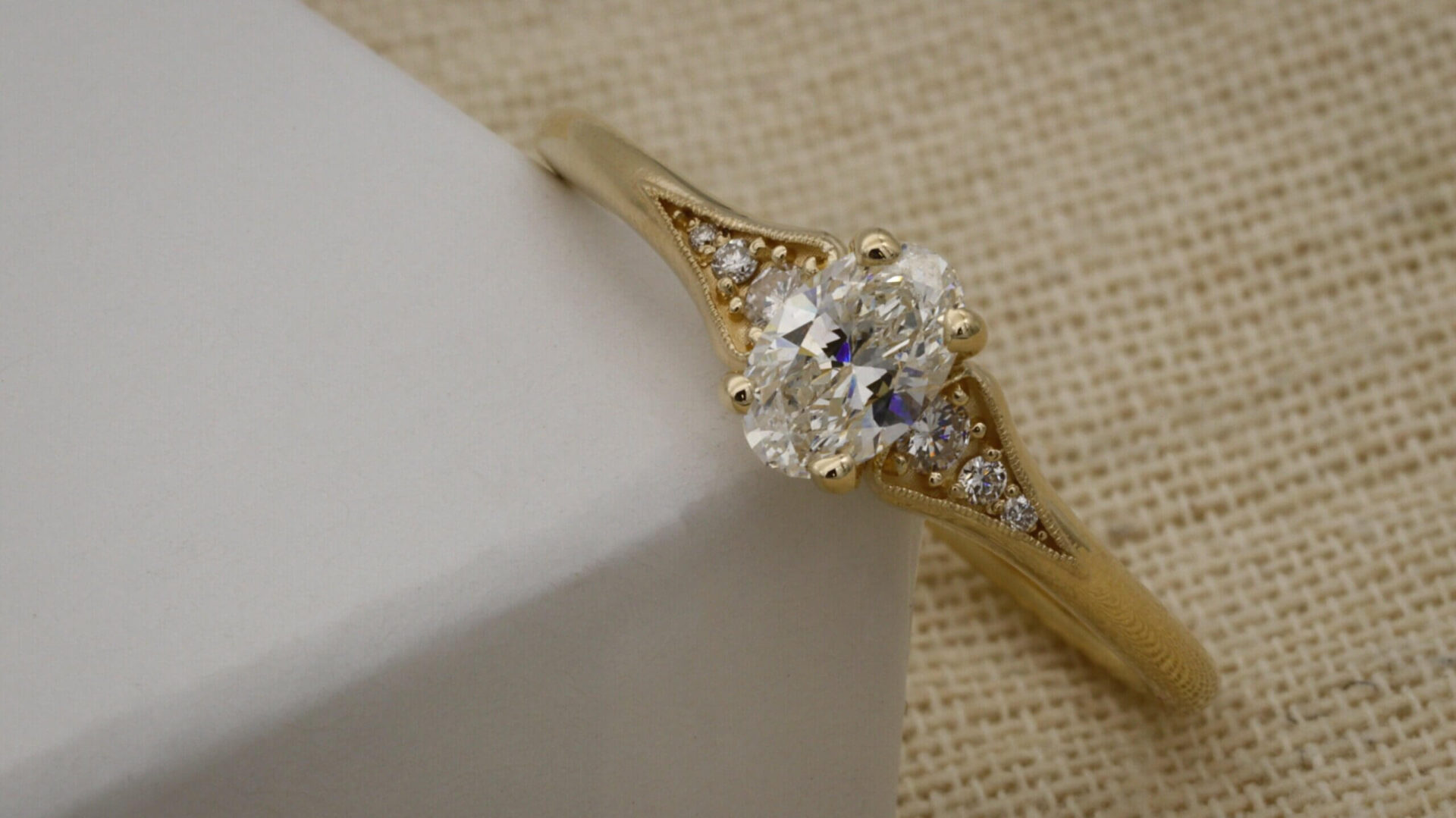
Market Insights and Average 1 Carat Diamond Prices
The diamond price chart, or the Rapaport Price List, is a chart that provides a benchmark to a diamond’s value based on its 4 C’s (cut, color, clarity, and carat). It was started by Martin Rapaport, who began in the diamond industry as a cleaver and rough sorter in Antwerp, Belgium. In 1975 he began brokering rough and polished diamonds in New York City, and then in 1978, he created the Rapaport Prices List.
Each Friday the list is released and is used as a standard for pricing all loose diamonds sold as individual stones. The diamonds are generally I3 or better in clarity and M or better in color. Here’s an example of the Rapaport price chart for round diamonds 1.00 to 1.49 carats.
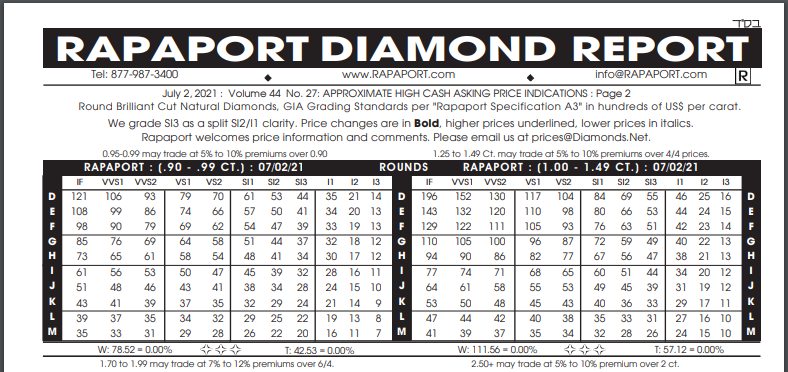
Credit: rapaport.com
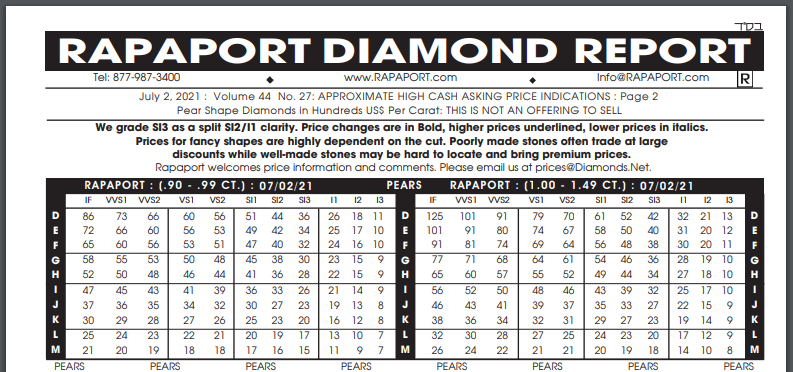
Credit: rapaport.com
*The Pear Price List is often used as a price guideline for all other diamond shapes.
Credit: rapaport.com
*The Pear Price List is often used as a price guideline for all other diamond shapes.
If you take a look at the highlighted cell in the following table, you will see that a 1-carat diamond with G color and SI1 clarity will cost around $7,200. This white diamond can work beautifully with both white gold and yellow gold bands.
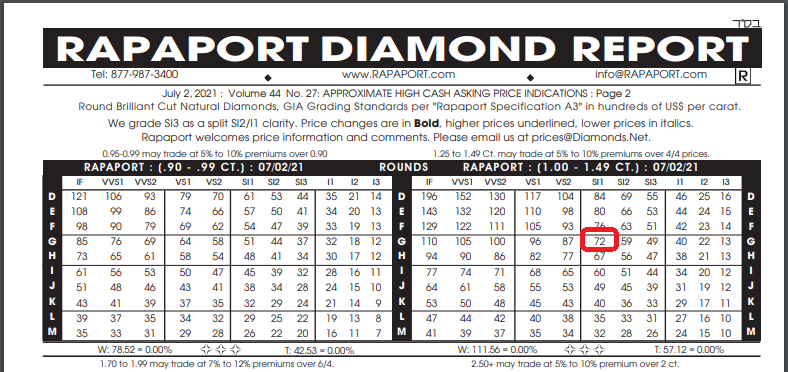
Credit: rapaport.com
As you can see, prices are determined by carat – but the price-per-carat changes quite dramatically depending on other factors like clarity and color.
As of July 2021, a 0.9 carat G color VS1 diamond of would have been worth $6,400 per carat (around $5,760) whereas a 0.9 carat M color VS1 diamond (with the only difference being color) would have been worth around $2,900 per carat – or around $2,610.
What to Expect in Terms of Price Ranges
You may have noticed by now that the Rapaport Diamond Report clearly notes that diamonds featuring a carat weight between 0.95 and 0.99 ‘may trade at 5% to 10% premium over 0.90’ – and a similar statement for other carat weights that sit just below magic weights like 1 carat, 1.5 carats, 2 carats and 3 carats.
This is precisely why a 1.5 carat diamond is not worth twice as much as a 0.75 carat diamond, or that a 2 carat diamond is worth way more than double the price of a 1 carat diamond – and why attempting to save money by looking at 0.99 carat diamonds instead of 1 carat diamonds, or searching ‘almost one carat diamond’, is not always going to prove all that effective.
So many of us are hoping to design an engagement ring that looks as impressive and beautiful as possible that two carat diamonds are seen as way more desirable than one carat diamonds. As a result, it makes perfect sense that value increases exponentially with weight, rather than gradually.
It’s a hard lesson to learn for a lot of shoppers, but one of the most important pieces of knowledge you can keep front and center in your mind as you shop.
Current Trends in Diamond Pricing
For almost a decade now, diamond prices have increased at an average of roughly 4% each year.
There are slight changes in price per carat more regularly than that – which is precisely why the Rapaport Diamond Report is issued each week – but these are relatively minor changes.
Natural vs Lab-Grown 1 Carat Diamonds
When deciding between a natural and a lab-grown 1 carat diamond, several key factors come into play. Breaking down these factors can help you make a more informed choice that aligns with your priorities and values.
Formation and Unique Characteristics
- Natural Diamonds:
Natural diamonds are formed over billions of years deep within the Earth. This lengthy natural process results in each diamond having its own unique characteristics and a timeless allure that many find deeply meaningful.
Price and Resale Value
- Natural Diamonds:
They often carry a higher price tag, typically ranging from $6,700 to $8,700 for a high-quality 1 carat stone. This cost reflects their rarity and the extensive mining process involved. Additionally, natural diamonds are valued for their potential resale value and the traditional romantic symbolism they embody. - Lab-Grown Diamonds:
Lab-grown diamonds offer a more affordable alternative, generally priced 50% to 70% lower than their natural counterparts. This significant cost difference allows buyers to allocate their budget towards other aspects of the engagement ring, such as the setting or additional accent stones.
Quality and Clarity
- Natural Diamonds:
Each natural diamond contains unique inclusions and characteristics formed naturally, which can add to their beauty and individuality. High-quality natural diamonds (e.g., IF or VVS clarity) are exceptionally brilliant and vibrant. - Lab-Grown Diamonds:
Created in controlled laboratory environments, lab-grown diamonds often exhibit fewer inclusions and can achieve higher clarity grades more affordably. They are chemically, physically, and optically identical to natural diamonds, making them indistinguishable to the naked eye.
Environmental and Ethical Considerations
- Natural Diamonds:
Mining natural diamonds can have significant environmental impacts, including habitat destruction and carbon emissions. Additionally, concerns about conflict diamonds (blood diamonds) persist despite certifications like the Kimberley Process. - Lab-Grown Diamonds:
Lab-grown diamonds are generally considered more environmentally friendly, as they require less land disruption and water usage. They also eliminate concerns related to conflict diamonds, providing peace of mind regarding ethical sourcing.
Resale Value
- Natural Diamonds:
Typically retain their value better over time due to their rarity and established market demand. They are often seen as a long-term investment. - Lab-Grown Diamonds:
Currently have a lower resale value compared to natural diamonds. However, as technology advances and market acceptance grows, this could change in the future.
Personal Preference and Symbolism
- Natural Diamonds:
Often carry a sense of tradition and romance, symbolizing enduring love forged over millennia. - Lab-Grown Diamonds:
Appeal to modern buyers who value technological advancements and sustainability, offering a contemporary take on classic beauty.
Making the Choice
Ultimately, the choice between natural and lab-grown 1 carat diamonds depends on individual priorities:
- Choose Natural Diamonds If You:
- Value tradition and the unique history of each stone.
- Are looking for a long-term investment with better resale value.
- Appreciate the natural formation process and its inherent rarity.
- Choose Lab-Grown Diamonds If You:
- Prioritize affordability without compromising on quality.
- Are eco-conscious and seek ethically sourced options.
- Prefer a higher clarity or better color grade within your budget.
Average Prices Comparison
To provide a clear comparison between lab-grown and natural 1 carat diamonds with similar specifications, consider the following average prices:
Round Diamonds:
| Type | Carat | Cut | Color | Clarity | Shape | Average Price |
|---|---|---|---|---|---|---|
| Lab-Grown | 1 | Excellent | F | VS2 | Round | $1,350 |
| Natural | 1 | Excellent | F | VS2 | Round | $6,450 |
Pear Diamonds:
| Type | Carat | Cut | Color | Clarity | Shape | Average Price |
|---|---|---|---|---|---|---|
| Lab-Grown | 1 | Excellent | F | VS2 | Pear | $1,032 |
| Natural | 1 | Excellent | F | VS2 | Pear | $4,800 |
The table below showcases the average prices for 1 carat diamonds with identical specifications, comparing lab-grown and natural options across two popular shapes. For Round diamonds with an Excellent cut, F color, and VS2 clarity, a lab-grown stone costs approximately $1,350, whereas a natural diamond with the same qualities is priced around $6,450. In the case of Pear-shaped diamonds, lab-grown variants are available for about $1,032, compared to natural Pear diamonds costing roughly $4,800. This comparison highlights the significant price difference between lab-grown and natural diamonds, offering substantial savings without compromising on quality.
Shopping Avenues: Online vs Retail
It is possible to find beautiful diamonds at a lower cost online since businesses don’t need to pay for the running costs associated with brick-and-mortar stores.
Diamonds sold online are cheaper because the sellers can make a larger number of daily sales without the cost of running a brick-and-mortar business or offering that highly important, in-person expertise and guidance to shoppers who would rather take their time than race to the checkout. For this reason, it’s important you’re selective about which online stores you look at. Plenty don’t invest the level of time and attention into each diamond that they should.
At WillYou, this is at the heart of what we do. Our resident diamond expert checks each diamond, while our team invests hours into providing every guide you could need when it comes to buying a diamond. This is what sets us apart.
Balancing Size and Quality
So, you know what you need to know about the diamond itself – but no diamond acts alone when you’re down on one knee, popping the question. It’s just as important to understand the specifics of creating and paying for a complete 1 carat diamond engagement ring as it is to understand the 1 carat diamond on its own.
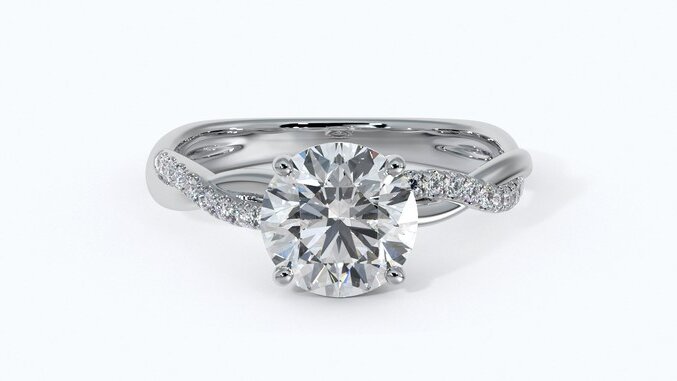
Ring Settings and Customisation Costs
A typical ring setting will cost around $1,500 – $,2000 – although, for most shoppers, it’s easier to think of their ring setting as representing around 15% of the total spend, with the diamond representing the other 85%.
Again, there’s no single, straightforward answer to the question of which ring setting is best, especially when it comes to customisation – which will depend entirely on how you choose to customise it. There are, however, plenty of factors to consider:
- Time and Complexity
Consider the fact that the level of craftsmanship, creative flair and originality – not to mention the sheer number of hours – that need to be put to use to create a ring setting will differ significantly, even in two pieces created by the same jeweler, and to the same high quality.
While creating an impeccable Solitaire Engagement Ring is no easy task, it will be simpler than creating a more ornate and unique piece designed to the buyer’s specific requirements. A design will need to be drawn up, modified, and created from scratch.
- Materials Used
You likely know already that gold, as one of the most coveted precious metals, it’s a pretty expensive choice – but, as a matter of fact, platinum tends to come out the more expensive choice, despite the fact that, per gram, its market price is lower.
This is because platinum jewelry features a much higher purity – around 99%, in most instances – whereas gold is rarely used at a purity higher than 18k (75% gold to 25% alloy), because of its natural softness and vulnerability to damage.
- Accents
The price of your diamond ring will also depend on its CTW, or Carat Total Weight, which is a number used to represent the combined carat weight of an item of jewelry featuring a number of accent (or ‘melee’) diamonds.
If, for instance, you were to choose this Round Halo Engagement Ring in Yellow Gold, then the CTW of the ring would be calculated based on the combined weights of each individual stone in the halo and pavé.
The combined value of the smaller, accent stones is, of course, likely to be far lower than the value of the center diamond, but it is still a factor to consider when calculating the potential price of your engagement ring.
Our Expert Take
The diamond will represent your biggest expense. It is important to keep this in mind and use that 75% as a rough guideline for your search, or you could end up saving too much on your diamond, and finding that you could have invested in a larger or higher quality stone.
Whatever your budget, breaking it down into these two separate expenses can be a useful way to frame your search for the right diamond. Comparing 75% of your budget against an up-to-date resource like the Rapaport Diamond Report can make it a lot easier for you to figure out the sort of diamond you can hope to afford, and where to start looking.
At the same time, it’s important to know how you can get the best deal possible. Read up on our guide to the Four Cs to learn about what’s important and what can be dropped to the bottom of your priorities list.
You can take a look at our full range of GIA certified one carat diamonds here – you may be surprised at how much choice there is. Just remember before getting into it, discovering the true value of a 1 carat diamond ring isn’t just about price; it’s about understanding the story and quality behind every sparkle.
7 FAQs
- Q: What is the average price of a 1 carat diamond?
- A: The average price of a 1 carat diamond typically ranges from $2,500 to $18,000. The exact price depends on factors like cut quality, clarity, color, and the specific diamond shape.
- Q: How does the cut quality affect the price of a 1 carat diamond?
- A: Cut quality significantly impacts a diamond’s price and beauty. A well-cut 1 carat diamond will be more expensive than a poorly cut diamond of the same carat weight due to its enhanced brilliance and sparkle.
- Q: Does the color grade significantly impact the price of a 1 carat diamond?
- A: Yes, the color grade affects the price. Diamonds closer to colorless (grade D) are typically more expensive than those with a slight yellow or brown tint (lower grades).
- Q: What is the cost difference between a natural and a lab-grown 1 carat diamond?
- A: Lab-grown 1 carat diamonds are generally less expensive than their natural counterparts. The price difference can be substantial, often ranging from 20% to 40% cheaper for lab-grown diamonds.
- Q: How much does a 1 carat diamond engagement ring cost?
- A: A 1 carat diamond engagement ring’s cost varies widely, generally between $3,000 and $25,000. The total cost includes the diamond and the setting, which can vary based on the ring’s design and the metal used.
- Q: Can the shape of the diamond affect its price?
- A: Yes, the shape of the diamond can influence its price. Round brilliant cuts are often the most expensive due to their popularity and the cutting process’s complexity, while shapes like princess, cushion, or oval may be less expensive.
- Q: Is a 1 carat diamond considered large for an engagement ring?
- A: A 1 carat diamond is considered a significant and popular size for an engagement ring, offering a balance between noticeable size and affordability.
Unveil the true worth of 1 carat diamonds with Jeweler AI – your expert guide in selecting the perfect engagement ring
Here are more specific diamond prices topics to browse:
- Melee Diamonds: The Perfect Accents to Enhance the Center Stone
- Small Diamond Engagement Rings: Big Sparkle Comes In Little Packages
- 0.25 Carat Diamond: Tiny Treasure or Just Too Small?
- The True Value of a 0.5 Carat Diamond Ring Revealed
- 0.7, 0.8, 0.9 Carat Diamond Showdown: Which One Wins?
- What You Should Pay for a 1.5 Carat Diamond Ring?
- Price Alert: How Much Should You Pay for a 2 Carat Diamond Ring?
- How Much Does a 2.5 Carat Diamond Really Cost?
- The Real Cost of a 3 Carat Diamond Ring
- Industry Secret: How Much Does a 4-Carat Diamond Ring Actually Cost?
- How Much is Too Much? The True Cost of 5 Carat Diamond Ring!
- 6 Carat Diamond Rings: Pricing Breakdown & Value Tips
- 7 Carat Diamond Rings: Affordable Luxury Prices Revealed
- 8 Carat Diamond Rings: Price Comparison & Savings Tips
- 9 Carat Diamond Rings: Detailed Pricing Guide & Best Deals
- 10-13 Carat Diamonds: The Ultimate Symbol of Luxury!
- 15 Carat Diamonds: Why Celebrities Love Them!
- Unveiling the Majesty: The Secrets Behind the 20 Carat Diamond Ring!
- Decoding the Grandeur: The Journey to Choosing a 25 Carat Diamond Ring
- Average Carat Size for Rings: What’s the Ideal?
- Understanding What Is CTTW Diamond In Engagement Ring
- The Truth About Why Diamonds Are So Expensive and Incredibly Valuable
FOLLOW-UP GUIDE SERIES

